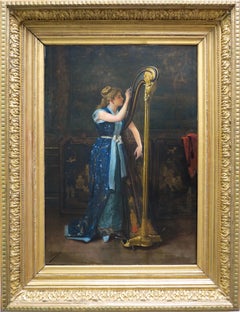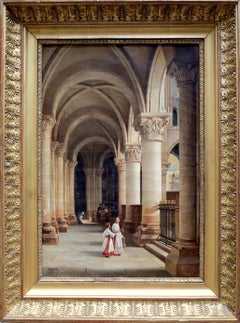Want more images or videos?
Request additional images or videos from the seller
1 of 7
UnknownSaul asking the Pythoness of Andor to summon the ghost of Samuelcirca 1800
circa 1800
$3,857.71List Price
About the Item
- Creation Year:circa 1800
- Dimensions:Height: 12.21 in (31 cm)Width: 16.54 in (42 cm)
- Medium:
- Movement & Style:
- Period:
- Condition:
- Gallery Location:Paris, FR
- Reference Number:Seller: T616 12 221stDibs: LU1954214205422
About the Seller
No Reviews Yet
Vetted Professional Seller
Every seller passes strict standards for authenticity and reliability
Established in 2014
1stDibs seller since 2022
13 sales on 1stDibs
Authenticity Guarantee
In the unlikely event there’s an issue with an item’s authenticity, contact us within 1 year for a full refund. DetailsMoney-Back Guarantee
If your item is not as described, is damaged in transit, or does not arrive, contact us within 7 days for a full refund. Details24-Hour Cancellation
You have a 24-hour grace period in which to reconsider your purchase, with no questions asked.Vetted Professional Sellers
Our world-class sellers must adhere to strict standards for service and quality, maintaining the integrity of our listings.Price-Match Guarantee
If you find that a seller listed the same item for a lower price elsewhere, we’ll match it.Trusted Global Delivery
Our best-in-class carrier network provides specialized shipping options worldwide, including custom delivery.You May Also Like
THE BEATIFUL FRAME - Angelo Granati - Figurative oil on canvas painting
By Angelo Granati
Located in Napoli, IT
THE BEAUTIFUL FRAME - Angelo Granati Italia 2003
Oil on canvas cm.90x70.
Gold leaf gilded wooden frame mis. ext.110X90
In this painting, Maestro Angelo Granati drew inspiration from the paintings of the French school.
Mom and daughter...
Category
Early 2000s French School Figurative Paintings
Materials
Canvas, Oil
$4,035
H 35.44 in W 27.56 in
The Tube - Painting Blue Green Grey Brown Orange Yellow White Black
Located in Sofia, BG
"The Tube" is a painting by Maestro Edele Bessy - MABILLOT GRANDJEAN GENEVIEVE
The painting is unframed.
Her paintings bring emotion of happiness, love, ene...
Category
2010s French School Interior Paintings
Materials
Oil, Canvas
$14,243
H 51.19 in W 38.19 in D 0.79 in
Best of Europe light flooded Palace Interior in grey blue green colorful accents
Located in Norwich, GB
The best of Europe. If you love the classically stylish opulence of French palaces and their marble fireplaces, their elegant panelling, their Versailles parquets - if you have wondered around Versailles or Fontainebleau palace, wondering what it might be like to live there - then this one is for you!
Our painting brings a light flooded, serene palace interior to you: a large room with a sculpture on the mantlepiece, and three large paintings...
Category
Early 20th Century French School Interior Paintings
Materials
Canvas, Oil
$2,000
H 27.17 in W 31.89 in D 1.58 in
The Letter, young lady in her boudoir 19th Century majestic miniature painting
Located in Norwich, GB
A majestic miniature painting by Victor Mongodin. Painted with extraordinary detail, it depicts a pretty young lady writing a letter in her boudoir. Mongodin clearly delights in painting fabrics... the silk of her skirt, the cotton of her camisole, as well as the luxurious velvets of the curtains and drapery. And then there is the mystery: who is she writing to?
Born in Vire in Normandy in 1819, Victor Mongodin had studied with de Rudder. Working in the French Capital...
Category
1860s French School Interior Paintings
Materials
Oil, Wood Panel
$1,250
H 11.42 in W 9.45 in D 0.4 in
The Cardinal Painting the Virgin Mary
Located in St. Albans, GB
This painting by Henri Brispot stands out amongst many pieces that he ever painted. It was sold in New York for $20 000 and is a wonderful example of his satirical nature shown throu...
Category
Late 19th Century French School Interior Paintings
Materials
Oil
$9,732 Sale Price
25% Off
H 37 in W 33 in D 5 in
A priest dinning in good company
Located in BELEYMAS, FR
Pierre DUVAL LECAMUS
(Lisieux 1790 - Saint-Cloud 1854)
Dinner in good company
Oil on canvas
H. 32.5 cm; W. 24.5 cm
Around 1820
Related works : - Painting from the 1822 Salon and kep...
Category
1820s French School Interior Paintings
Materials
Canvas, Oil
Blue chair, original canvas by Pierre Coquet
Located in Montfort l’Amaury, FR
Blue chair, original painting by Pierre Coquet (1926-2021)
Oil on paper laid on a board, signed in the bottom right
38 x 41 cm (43 x 46 x 3,5cm frame included)
In a Pierre Bonnard s...
Category
1990s French School Figurative Paintings
Materials
Oil
Nature morte dans l'atelier/Still life in the workshop
Located in Montfort l’Amaury, FR
Reference number F356
Framed with an ebony color wood floated frame.
61 x 44 cm frame included (41 x 24 cm without frame)
This work is painted with oil on a board and placed in a mad...
Category
1980s French School Figurative Paintings
Materials
Oil, Board
$1,709 Sale Price
20% Off
H 24.02 in W 17.33 in D 1.58 in
Nature morte cubiste/Cubist still life
Located in Montfort l’Amaury, FR
Reference number F355
Framed with a ebony color floated frame
41 x 60 cm frame included (27 x 46 cm without frame)
This work is painted with oil on a board. Stamp of the signature in...
Category
1980s French School Figurative Paintings
Materials
Oil, Board
$1,709 Sale Price
20% Off
H 16.15 in W 23.63 in D 1.58 in
L'étole aux cerises/Blue stole with cherries
Located in Montfort l’Amaury, FR
Reference number F186b
Framed with a natural oak floated frame
33 x 35 cm frame included (28 x 30 cm without frame)
This work is painted with oil on a paper that is mounted on a boar...
Category
1990s French School Figurative Paintings
Materials
Oil
$1,614 Sale Price
20% Off
H 13 in W 13.78 in D 1.38 in
More From This Seller
View AllMeditation
By Leon Lhermitte
Located in Paris, IDF
Circle of Léon Lhermitte (1844-1925)
Meditation
Oil on canvas
32 x 24 cm
This painting depicts an old man seated on a chair, his hands clasped in his lap, his gaze lowered, pensiv...
Category
Late 19th Century French School Figurative Paintings
Materials
Oil
$2,136
The Harpist
By Auguste Serrure
Located in Paris, IDF
Auguste SERRURE
(Antwerp, 1825 – Schaerbeek, 1903)
The harpist
Oil on panel
Signed lower left
72 x 50 cm without frame
99 x 76 cm with frame
Circa 1884
Related work: large paintin...
Category
Late 19th Century French School Figurative Paintings
Materials
Oil
View of one of the aisles of the apse of Saint-Germain-des-Prés, Paris, France
Located in Paris, IDF
Alexis Pierre MILON
(Rouen, 1784 - After 1858)
View of one of the aisles of the apse of Saint-Germain-des-Prés
Oil on canvas
Signed and dated lower left
50.5 x 34.5 cm
1838
Exhibi...
Category
Mid-19th Century French School Interior Paintings
Materials
Oil
Dream of freedom
By Eliseo Sala
Located in Paris, IDF
Eliseo SALA, attributed to
(Milan, 1813 – Triuggio, 1879)
Dream of freedom
Oil on canvas
46 x 38 cm without frame
66x 57 with frame
Around 1846
Related work: La toeletta del matti...
Category
Mid-19th Century Italian School Figurative Paintings
Materials
Oil
Hyena head
Located in Paris, IDF
Joseph Urbain MÉLIN
(Paris, 1814 – Avon, 1886)
Hyena head
Oil on canvas
Signed and dated lower right
40,5 x 32 cm without frame
65 x 57 cm with frame
1854
Born in Paris on Februar...
Category
Mid-19th Century French School Animal Paintings
Materials
Oil
Red-breasted Merganser
Located in Paris, IDF
Alexandre Jean-Baptiste THEUVENOT
(Port-sur-Saône, 1834 – Paris, 1882)
Red-breasted Merganser
Oil on canvas
Signed at the bottom
78 x 56 cm
Born in 1884 in Port-sur-Saône (Haute-S...
Category
Late 19th Century French School Still-life Paintings
Materials
Oil

